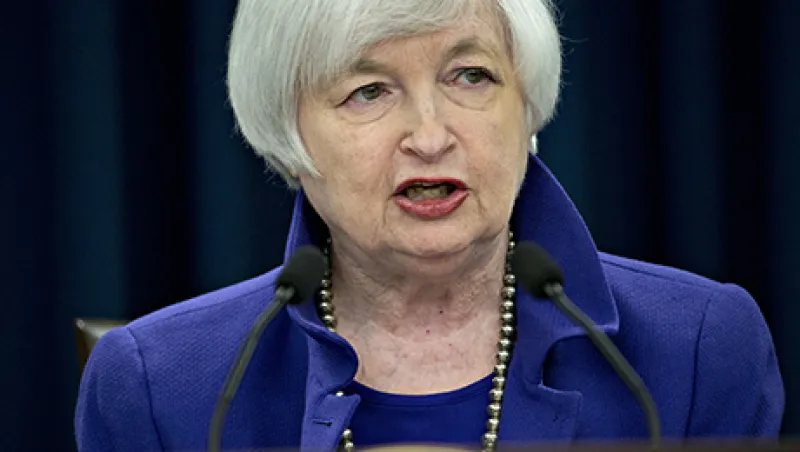To the surprise of almost no one, the Federal Reserve announcement yesterday confirmed that seven years of extraordinary accommodation by the U.S. central bank has finally come to an end. In addition to the unanimous vote by the Federal Open Market Committee to raise the fed-funds target rate by 25 basis points, the bank’s dot plot now indicates that the benchmark will be between 1.25 and 1.5 percent at year-end 2016. Critically, the bank’s policymakers made it clear that there will be no reduction of its bloated balance sheet “until normalization of the level of the federal-funds rate is well under way.” Additionally, during the accompanying press conference, Fed Chair Janet Yellen said that the bank is monitoring recent tremors in high-yield bond markets closely. This confirmation of a cautious Fed extended the early-day gain for U.S. equities as investors factored in a near-future in which rates remain at historically low levels.
Puerto Rico set to default. In a speech before the National Press Club in Washington on Wednesday, Puerto Rico Governor Alejandro Garcia Padilla said that the island territory will default in January or May. Padilla’s speech occurred the same day Congress passed a spending bill that included $900 million in healthcare funding in the coming decade but did not address any federal bailout for Puerto Rico, with its crippling $70 billion in debt.
BTG Pactual get lifeline from Brazil’s central bank. Embattled Brazilian investment bank Grupo BTG Pactual received badly needed help from the Banco Central do Brasil Wednesday. The central bank eliminated reserves required when accessing special liquidity facilities and, while the new guidelines apply to all banks, was clearly intended to assist BTG Pactual, which accessed $1.5 billion earlier in December to shore up capital after the arrest and jailing of its founder and CEO in a corruption probe.
GE set to reap windfall from asset sales. In an investor presentation on Wednesday, Fairfield, Connecticut-based General Electric stated that roughly $26 billion will flow to shareholder in 2016 in dividends and an expanded buyback program. The payout comes as the company continues to liquidate its massive financial services business to return to an industrial focus.
Fedex earnings surprise to the upside. Global delivery company FedEx Corp. on Wedsnday announced third quarter results with adjusted earnings per share of $2.58 versus consensus analysts’ projections for $2.50. Management of the Memphis, Tennessee giant remained positive on prospects for 2016 volume growth, despite pressure on margins and declines in some freight segments.
AstraZeneca to acquire cancer drugmaker. In the latest major pharmaceutical deal, London-based AstraZeneca Thursday announced an agreement to acquire a control stake in Acerta Pharma, based in Oss, the Netherlands, in a deal valued at roughly $4 billion. The transaction will provide AstraZeneca access to Acerta’s successful blood cancer treatment acalabrutinib.
German Business Confidence stumbles. Data released today by the Ifo Institute indicates that German corporate leaders may be less bullish on the ability of the European Central Bank to kickstart growth in the region. The headline business climate index declined sequentially to 108.7 versus a reading of 109 in November while both the current assessment and expectations specific indices also registered weaker than consensus forecasts.
Mixed voter signals as Brexit vote inches closer. Polling groups speaking to U.K. citizens about the upcoming referendum to remain within the European Union have returned widely divergent results in recent weeks, with results issued today sponsored by a conservative lobby group showing a majority in favor of an exit while a survey firm reported the opposite conclusion Wednesday. Prime Minister David Cameron has lobbied for European Union leadership to allow Britain to remain within the group while retaining a greater degree of economic and legal autonomy.
Portfolio Perspective: Good trajectory for the Bond Market, but Likely a Bumpy Ride.
The Fed’s first rate hike of presumably what will be a multi-year rate hike cycle has been a long time coming. In some sense, ever since the last rate cut to zero and QE arrived in 2008, the Fed has been very concerned with how they would extricate themselves from their multi-year exercise in non-conventional monetary policy. And now we are finally seeing that process set in reverse. We’re beyond bond buying and taper; beyond the cooling-off period; and now, we’re just past the first rate hike. So what’s next?
Big picture, we’ve seen a clear cycle repeat with each of the Fed’s major steps towards exit from their-hyper accommodative post- global financial crisis posture. In each case, we’ve seen markets boost risk premiums by both bear-steepening the yield curve and pushing spreads wider on non-governments. We saw that after the taper announcement mid-2013; we saw it as taper process completed in 2014H2, effectively starting the countdown to rate hikes; and we’ve seen it in the second half of 2015 as the Fed has worked up to the actual liftoff.
So what to expect from here? In short, a good trajectory for the bond market, but likely a bit of a bumpy ride. The good trajectory should come from two things. First, valuations. The market is well braced for what the Fed is likely to deliver in terms of rate hikes, so long-term Treasury yields are likely to remain low and range-bound. And second, well beyond the reasonable value in Treasuries, select spread product in virtually all sectors—structured products, hard currency emerging markets, medium-grade municipals and both investment-grade and high-yield corporates—look attractive relative to the underlying fundamentals. So those favorable valuations, against the backdrop of moderate growth and inflation, and a Fed that won’t want to derail the economy, suggests that fixed income returns should be healthy.
Why a bumpy ride? As the economic data rises and falls quarter to quarter, as the spread markets experience bouts of heavy supply, as mutual-fund flows fluctuate, as weak commodity prices weigh on some issuers, geopolitics, etc., spreads and rates will fluctuate, as we’ve seen in recent years.
So in summary, [this is] a first step for the Fed, but presumably they’ll tread cautiously from here. The bond market, importantly, looks well braced for the rate-hike cycle, setting up 2016 to be a year of decent returns from fixed income, especially the higher yielding sectors. Finally, while various crosscurrents may create volatility, we continue to expect above-average opportunities for adding value through active management activities, including sector rotation, issue selection as well as duration and currency.
Robert Tipp is the chief investment strategist of Prudential Fixed Income in Newark, N.J.






